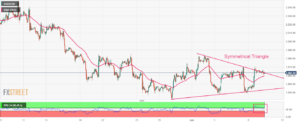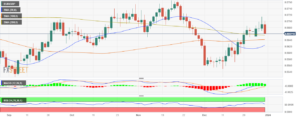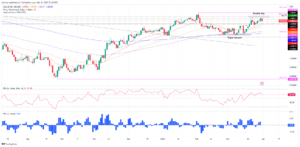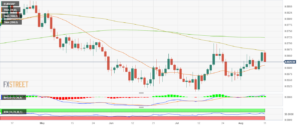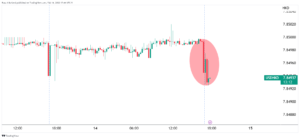
- The DXY Index trades with gains in the latest session.
- Investors eagerly await Nonfarm Payrolls, Average Hourly Earnings, Unemployment Rate from December, and FOMC Minutes disclosures.
- Rising US bond yields gave the US Dollar traction.
The US Dollar (USD) began trading at 102.10, marking a noteworthy rise in the index. This upward movement may be explained by markets awaiting direction, and investors seeking refuge in the USD ahead of key labor market reports to be released this week.
In the last meeting of 2023, the Federal Reserve adopted a dovish stance, remaining optimistic about easing inflation trends and ruling out rate hikes in 2024. Despite an indicative 75 bps easing forecast, future actions may alter with incoming data, such as the imminent December labor reports. Market speculations for March and May anticipate rate cuts and small odds for the easing cycle to start in the upcoming meeting in January, which may limit the USD’s momentum.
Daily Market Movers: US Dollar strengthens on the back of US yields recovering despite weak S&P revisions
- The US dollar experiences a positive trade ahead of the labor market data, demonstrating an upward momentum.
- December's revisions from the Manufacturing PMI reported by S&P Global came in at 47.9, falling short of the consensus estimate of 48.2, indicating a slowdown in the manufacturing sector.
- This week, the US will report key labor market figures from December, including the Unemployment Rate, Nonfarm Payrolls, and Average Hourly Earnings. Investors are also keenly waiting for the FOMC Minutes this Wednesday from the last meeting from 2023.
- The US bond yields are on the rise, with the 2-year, 5-year, and 10-year yields trading at 4.32%, 3.91%, and 3.94%, respectively.
- As per the CME FedWatch tool, markets have priced in no hike for the upcoming January meeting, with a mere 15% odds for a rate cut. The markets have also forecasted rate cuts for March and May 2024.
Technical Analysis: DXY bear-dominance persists despite hints of possible short-term bullish reversal
The Relative Strength Index (RSI) paints an optimistic picture as it displays a positive slope in negative territory. This suggests an increasing buying momentum as the index may be embarking on a potential reversal after hitting oversold conditions.
The Moving Average Convergence Divergence (MACD) further strengthens this bullish narrative, presenting rising green bars. This indicates the strengthening of upward momentum and a potential continuation of a bullish trend in the short term.
Yet, when glancing at the Simple Moving Averages (SMAs), the index is trading below the 20, 100, and 200-day SMAs. This predominantly reveals the bearish pressure in the market, overriding the short-term bullish signals of the RSI and MACD.
Support levels: 102.00, 101.50, 101.30.
Resistance levels: 102.40 (20-day SMA), 102.50, 102.70.
(This story was corrected on January 2 at 16:30 GMT to correct the second DXY support level from 102.50 to 101.50.)
Central banks FAQs
Central Banks have a key mandate which is making sure that there is price stability in a country or region. Economies are constantly facing inflation or deflation when prices for certain goods and services are fluctuating. Constant rising prices for the same goods means inflation, constant lowered prices for the same goods means deflation. It is the task of the central bank to keep the demand in line by tweaking its policy rate. For the biggest central banks like the US Federal Reserve (Fed), the European Central Bank (ECB) or the Bank of England (BoE), the mandate is to keep inflation close to 2%.
A central bank has one important tool at its disposal to get inflation higher or lower, and that is by tweaking its benchmark policy rate, commonly known as interest rate. On pre-communicated moments, the central bank will issue a statement with its policy rate and provide additional reasoning on why it is either remaining or changing (cutting or hiking) it. Local banks will adjust their savings and lending rates accordingly, which in turn will make it either harder or easier for people to earn on their savings or for companies to take out loans and make investments in their businesses. When the central bank hikes interest rates substantially, this is called monetary tightening. When it is cutting its benchmark rate, it is called monetary easing.
A central bank is often politically independent. Members of the central bank policy board are passing through a series of panels and hearings before being appointed to a policy board seat. Each member in that board often has a certain conviction on how the central bank should control inflation and the subsequent monetary policy. Members that want a very loose monetary policy, with low rates and cheap lending, to boost the economy substantially while being content to see inflation slightly above 2%, are called ‘doves’. Members that rather want to see higher rates to reward savings and want to keep a lit on inflation at all time are called ‘hawks’ and will not rest until inflation is at or just below 2%.
Normally, there is a chairman or president who leads each meeting, needs to create a consensus between the hawks or doves and has his or her final say when it would come down to a vote split to avoid a 50-50 tie on whether the current policy should be adjusted. The chairman will deliver speeches which often can be followed live, where the current monetary stance and outlook is being communicated. A central bank will try to push forward its monetary policy without triggering violent swings in rates, equities, or its currency. All members of the central bank will channel their stance toward the markets in advance of a policy meeting event. A few days before a policy meeting takes place until the new policy has been communicated, members are forbidden to talk publicly. This is called the blackout period.
- SEO Powered Content & PR Distribution. Get Amplified Today.
- PlatoData.Network Vertical Generative Ai. Empower Yourself. Access Here.
- PlatoAiStream. Web3 Intelligence. Knowledge Amplified. Access Here.
- PlatoESG. Carbon, CleanTech, Energy, Environment, Solar, Waste Management. Access Here.
- PlatoHealth. Biotech and Clinical Trials Intelligence. Access Here.
- Source: https://www.fxstreet.com/news/us-dollar-gains-ahead-of-key-labor-market-data-202401021620
- :has
- :is
- :not
- :where
- ][p
- 10
- 100
- 102
- 15%
- 16
- 2%
- 20
- 2023
- 2024
- 30
- 33
- 36
- 40
- 50
- 70
- 75
- 9
- a
- About
- above
- accordingly
- actions
- Additional
- adjust
- Adjusted
- adopted
- advance
- After
- ahead
- All
- also
- Amid
- an
- analysis
- and
- Animate
- anticipate
- appointed
- ARE
- AS
- At
- average
- avoid
- await
- awaiting
- back
- Bank
- Bank of England
- Bank of England (BOE)
- Banks
- bars
- BE
- bearish
- been
- before
- began
- being
- below
- Benchmark
- Benchmark Rate
- between
- Biggest
- board
- BoE
- bond
- Bond yields
- boost
- Bullish
- businesses
- Buying
- by
- called
- came
- CAN
- central
- Central Bank
- Central Banks
- certain
- chairman
- changing
- Channel
- cheap
- Close
- CME
- come
- commonly
- communicated
- Companies
- conditions
- Consensus
- constant
- constantly
- content
- continuation
- control
- control inflation
- Convergence
- conviction
- correct
- corrected
- country
- create
- Currency
- Current
- Cut
- cuts
- cutting
- cycle
- data
- Days
- December
- deflation
- deliver
- Demand
- demonstrating
- Despite
- direction
- Disclosures
- displays
- disposal
- Divergence
- Dollar
- Dovish
- down
- Dxy
- each
- eagerly
- earn
- Earnings
- easier
- easing
- ECB
- economies
- economy
- either
- ends
- England
- Equities
- estimate
- European
- European Central Bank
- Event
- expanded
- Experiences
- explained
- facing
- Falling
- falling short
- FAQ
- Fed
- Federal
- federal reserve
- few
- Figures
- final
- Flows
- followed
- FOMC
- fomc minutes
- For
- Forward
- from
- further
- future
- Gains
- gave
- get
- Global
- GMT
- goods
- Green
- harder
- Have
- her
- higher
- Hike
- Hikes
- hiking
- hints
- his
- hitting
- How
- HTTPS
- important
- in
- Including
- Incoming
- increasing
- independent
- index
- indicates
- indicating
- indicative
- inflation
- interest
- INTEREST RATE
- Interest Rates
- Investments
- Investors
- issue
- IT
- ITS
- January
- jpg
- just
- Keep
- Key
- known
- labor
- labor market
- Last
- latest
- Leads
- lending
- Level
- levels
- like
- LIMIT
- Line
- live
- Loans
- local
- LOCAL BANKS
- Low
- low rates
- lower
- lowered
- MACD
- make
- Making
- mandate
- manufacturing
- Manufacturing sector
- March
- Market
- Market Data
- Markets
- marking
- May 2024
- May..
- means
- meeting
- member
- Members
- mere
- minutes
- module
- Moments
- Momentum
- Monetary
- Monetary Policy
- monetary tightening
- movement
- Movers
- moving
- moving average
- moving averages
- NARRATIVE
- needs
- negative
- negative territory
- New
- new policy
- no
- Nonfarm
- Nonfarm Payrolls
- note
- noteworthy
- Odds
- of
- off
- often
- on
- ONE
- Optimistic
- or
- out
- Outlook
- overriding
- panels
- Passing
- Payrolls
- People
- per
- period
- persists
- picture
- Place
- plato
- Plato Data Intelligence
- PlatoData
- pmi
- policy
- politically
- positive
- possible
- potential
- predominantly
- president
- pressure
- price
- Prices
- provide
- publicly
- Push
- Rate
- rate hikes
- Rates
- rather
- recovering
- region
- relative
- relative strength index
- Relative Strength Index (RSI)
- released
- remaining
- report
- Reported
- Reports
- Reserve
- respectively
- REST
- Reveals
- Reversal
- revisions
- Reward
- Rise
- rising
- Risk
- rsi
- ruling
- s
- S&P
- S&P Global
- same
- Savings
- say
- Second
- sector
- see
- seeking
- Series
- Services
- session
- Short
- short-term
- should
- signals
- Simple
- Slope
- Slowdown
- SMA
- small
- SMAs
- speeches
- split
- Stability
- stance
- start
- starts
- Statement
- Story
- strength
- strengthening
- Strengthens
- strong
- subsequent
- substantially
- such
- Suggests
- support
- support level
- sure
- Swings
- Take
- takes
- Talk
- Task
- term
- territory
- that
- The
- The US Federal Reserve
- their
- There.
- this
- this week
- Through
- TIE
- tightening
- time
- to
- tool
- toward
- traction
- trade
- trades
- Trading
- Trend
- Trends
- triggering
- try
- TURN
- tweaking
- unemployment
- unemployment rate
- until
- upcoming
- upward
- upward momentum
- us
- US bond yields
- US Dollar
- US Federal
- us federal reserve
- US yields
- USD
- very
- Vote
- Waiting
- want
- was
- Wednesday
- week
- when
- whether
- which
- while
- WHO
- why
- will
- with
- without
- would
- year
- yields
- zephyrnet

